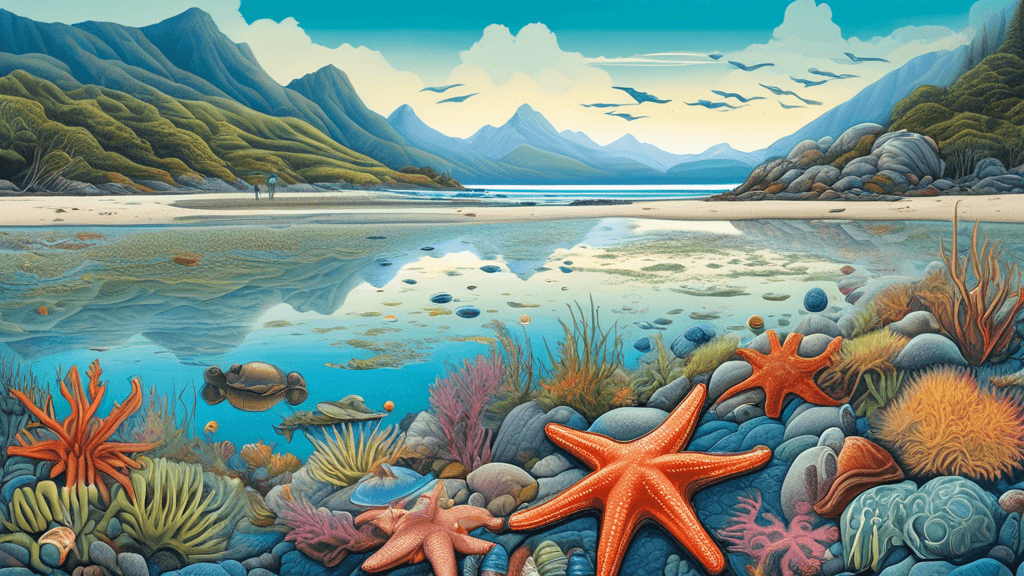
Exploring New Zealand's Inter-tidal Zones: A Journey Between the Tides
Share
Introduction to New Zealand's Inter-tidal Zones
New Zealand, with its extensive coastline, offers a unique opportunity to explore one of nature's most fascinating ecosystems: the inter-tidal zone. This dynamic habitat, existing between the high and low tide marks, is home to a diverse array of organisms that have adapted in remarkable ways to survive in changing environments. But what makes these zones so special, and why are they crucial for both ecological balance and artistic inspiration?
Understanding the Inter-tidal Zones
Inter-tidal zones, often seen as the interface between the ocean and the land, are areas that are underwater during high tide and exposed to the air at low tide. This exposure to fluctuating conditions makes these zones incredibly biologically productive. Here, organisms face various challenges, from desiccation and extreme temperature fluctuations to the sheer physical force of waves. The resilience and adaptability of inter-tidal life forms are nothing short of extraordinary.
The Zones of Life in Inter-tidal Areas
The inter-tidal zone is generally divided into three areas: the upper, middle, and lower inter-tidal zones. Each zone has distinct characteristics and hosts different species adapted to the specific conditions of that zone:
- Upper inter-tidal zone: Often only submerged during the highest tides, species here are well adapted to drying out.
- Middle inter-tidal zone: This area experiences frequent and prolonged periods of submersion and exposure, creating a challenging environment for many organisms.
- Lower inter-tidal zone: Mostly underwater, only exposed during the lowest tides, supporting species that require constant moisture.
The Ecological Importance of Inter-tidal Zones
This ecosystem plays a pivotal role in coastal ecology. It acts as a buffer that protects the shorelines from erosion, absorbs impacts from storms, and filters nutrients and pollutants, maintaining coastal water quality. Moreover, the productivity of the inter-tidal zones supports a diverse food web, essential for both aquatic and terrestrial species.
Species Diversity and Adaptation
The species found within New Zealand's inter-tidal zones are as varied as the environment itself, ranging from tiny microorganisms to larger fish and birds. Some notable adaptations include:
- Shellfish: Mussels and clams anchor themselves to rocks and each other, forming dense clusters that resist strong tidal currents and waves.
- Crustaceans: Crabs can regulate their internal salt concentration, allowing them to survive as salinity varies.
- Seaweed: Forms like kelp attach firmly to rocky surfaces, with flexible stipes and blades that withstand water movement.
Conservation Challenges and Opportunities
Like many ecosystems, New Zealand's inter-tidal zones face threats from human activities, including pollution, climate change, and habitat disturbance. Conservation efforts are vital to preserve these natural treasures. Establishing protected marine areas and encouraging sustainable tourism and fishing can help to mitigate these impacts. Furthermore, educating the public about the significance of these zones can foster more responsible interactions with these delicate habitats.
Photographic and Artistic Inspiration
For photographers and artists, the inter-tidal zone offers a rich tapeste ot it visually and intellectually. The stark contrasts between exposed and submerged environments, coupled with the variety of life forms, provide endless opportunities for creative expression. Capturing these moments can also play a role in conservation, as compelling images and artwork can help to raise awareness and inspire action.
Conclusion: The Call to Explore and Protect
Exploring New Zealand's inter-tidal zones reveals the fragile beauty and resilience of these ecosystems. As environmental stewards, photographers, artists, and nature enthusiasts, we have the opportunity—and the responsibility—to appreciate, document, and protect these areas. By understanding the delicate balance and the intricate connections between the organisms and their habitats, we can better appreciate how our actions impact the natural world.
Whether you are drawn to these zones for their ecological importance, their beauty, or the photograph therapeutic opportunities they offer, remember that each visit should be conducted with respect for the habitat and its inhabitants. Let us tread lightly and responsibly, ensuring that future generations can also enjoy and learn from Newpressures, Zealand's marvelous inter-tidal zones.





